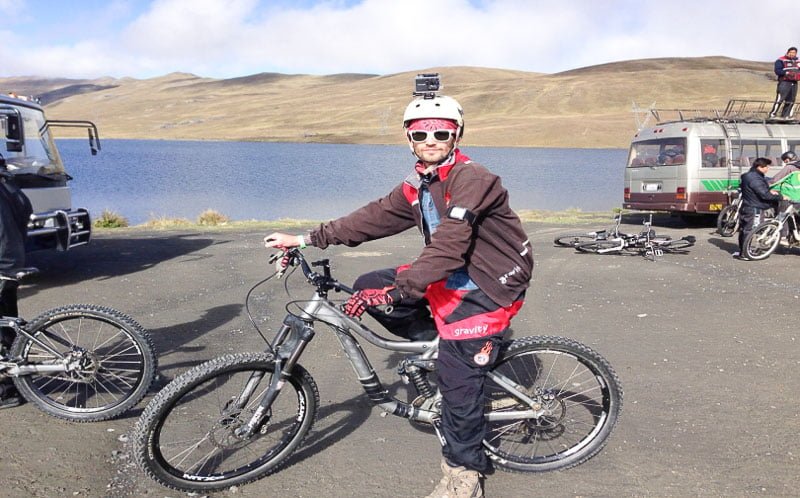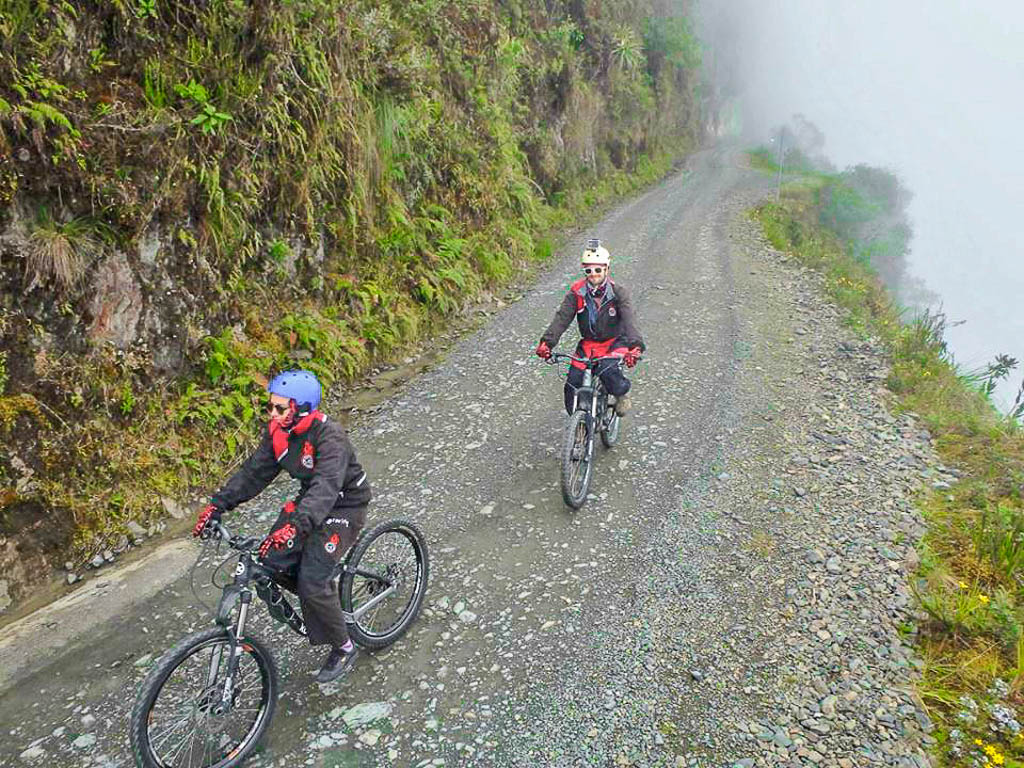This article has links to products and services we love, which we may make commission from.
Are you brave enough to bike Death Road in Bolivia? Coined the ‘most dangerous road in the world’, visitors cycle the 69 kilometres/43 miles day trip from La Paz every day, with a group of fellow daredevils for support.
Along with the Uyuni’s Salt Flats, Death Road biking is one of the most popular attractions in Bolivia. So let’s pedal into what you should know before you go.
» You may also like | 10 Unmissable things to do in La Paz
1. How Many Hours is the Death Road Cycle?
The first advice in our biking Death Road guide is the timeframe you will need to set aside during your Bolivia itinerary.
You will easily spend two days in La Paz, Bolivia’s capital.
Especially if you are planning on partying in one of the highest cities in the world.
The day trip to La Carretera de los Yungas, which is the road’s traditional name, requires a very early rise and takes up most of the day.

The day kicks off with a short meeting, paperwork and approx. an hour bus ride to La Cumbre ‘The Summit’ which is 4700 above sea level (asl).
On arrival, you are kitted out and set on the first leg which is a smooth road.
Don’t be fooled by the terrain, the lorry drivers which you share the road with are mental.
This is leg is just over one hour on a developed road to ease you into the official ride.
The Death Road cycle itself is four hours with stops and then lunch.
2. How To Choose Which Of The Death Road Bolivia Tours To Go With
There’s plenty of choice between Death Road tours and you will see adverts for many companies in La Paz hostels, on associated websites and through booking agents.
Things to consider:
- Quality of kit and bike
- Safety of bus and driver, you will hear countless stories about South American bus crashes during your travels
- Company reviews
Your tour of choice must provide:
- Protective coat and trousers in case you fall on gravel
- Gloves
- A helmet
- A bike with great suspension and brakes
- They usually provide a drinks bottle too
We went with the most popular company, Gravity.
You can see the tour and reserve your spot in full here.

3. You Have To Pay An Entrance Fee
After the first leg, you arrive at the official entry point and this is where you pay the additional 25 bs per person to cycle the Death Road.
Remember to pack the extra cash. You may want a little more of the end of cycle activities and lunch options.
Once everyone has paid up, the group are asked if they want to cycle uphill, with altitude against them, or take the bus to the start of the route. A unanimous vote for the bus!
4. You Don’t Need To Be An Expert
Used to Amsterdam cycling and not sure if this attraction is for you?
You don’t need to be a mountain bike expert to cycle Death Road but it does help if you can cycle confidently and are not afraid of heights.
Be prepared to take on hairpin bends and heights f 11,800 feet (3,600 meters) between La Cumbre Pass and the lowland town of Coroico.
Have you seen Death Road on Top Gear?
5. Death Road Isn’t For Everyone
Contrary to believe, the road doesn’t get its title as ‘most dangerous’ because of the number of cycle victims.
The name originated from the number of deaths the road caused during the construction of it and it was not Bolivians that built it.
War prisoners from Paraguay were responsible for La Carretera de los Yungas to give it its real name.
However, if you find that once you start the route that the ride isn’t for you, don’t worry.
Just tell your guide and they will organise of you to sit on the bus which meets the rest of the crew at the bottom.
Still persevering? Don’t be afraid to be the one at the back. That was me, and my new friend Kristian.
I honestly felt like I was going 60 mph, on reflection and watching the video back, it was more like 6 mph.
6. Listen to Your Guide
So now you know the real reason for its title, it doesn’t mean its time to get cocky.
It is still claimed hundreds of people lose their lives on this road every year.
Recently a 21-year-old cycled off one of the cliffs and miraculously survived, being saved by a ledge.
It’s not just yourself you have to be cautious of, locals still use this road to drive between villages, when you see it you will think how?!
Listen to the advice from your guide who will talk you through the best options for balancing and maintaining control.
Plus, your guide will show you where to get the Instagram cliff shot souvenir!
It’s likely your main guide with have a wingman, one will take the lead and the other with kick back.
7. Death Road Cycle Packing List and Gear
- Wear flexible pants like leggings and tracksuit bottoms
- Layers, merino wool is ideal
- Bring additional liner gloves if you can, it gets really cold
- Wear closed-toe shoes such as trainers/sneakers
- Sunscreen
- Shades
- Swimming gear if taking a dip
- Towel if taking a post-cycle shower
8. Celebrate With A Beer
Once you make it through Cotapata National Park, with the Andes as the backdrop, and to the endpoint (Yolosa at 1200 asl), collect your celebratory beer, take a group selfie and chill for a while.
9. Lunch Is Included
Once everyone is reunited, the team embark on a buffet lunch.
Here you can have a shower and/or take a dip in the swimming pool before the bus ride all the way back on the mountain and back to La Paz.
10. Wear The T-Shirt
Been there, done that and now you can wear the t-shirt!
Most tour companies provide a brand T and buff for around your neck to prove you cycled the world’s most dangerous road in Bolivia!
Final Words
Whether you are an active cyclist with a need for speed or a backpacker looking to tick off a bucket list item, La Paz’s Death Road is a fun day out.
Calling all thrill-seekers! Are you brave enough to volcano board down an active volcano? We did in Nicaragua!
Pin to your Bolivia planning board!
Any questions? Just leave them below and we will get back to you.

We worked with our affiliate partner Tinggly who comped two Death Road cycle tours. Our honest opinion as always.







Hi
Great reading and up for it
The suggestion of using gravity. I phoned them and spoke to a really
helpful guy who informed me they don’t exsist any more .
Any other suggestions please
Nick
Hi Nick, thanks for the message. I just did a quick check and Gravity are still active on their Facebook. Enjoy the ride! ~ Gemma